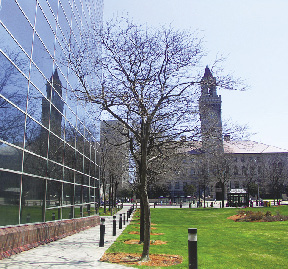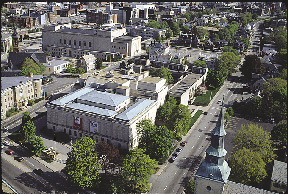In February 1955, The National Geographic Magazine highlighted the business might of Worcester in the article "Cities Like Worcester Make America." With headings including "Persistence, Resistance, and Success" and "Yankee Ingenuity Finds a Way," Worcester was touted as a "city of industry made so by the character of its citizens." Today, that persistent character has sparked a new wave of ingenuity attracting such industries and employers as insurance (Allmerica Financial/Hanover Insurance Group and Unum Provident), banking (Commerce Bank & Trust Co., Flagship Bank & Trust, Co.), high technology (Allegro Microsystems Inc.), and biotechnology (Abbott Bioresearch Corp.), while retaining some of the very same industries highlighted in the 1955 article, including abrasives (Saint-Gobain Abrasives, Inc., formerly Norton Company) and metal forging (Wyman-Gordon Company, Morgan Construction Company).
The city of Worcester, with a population of nearly 176,000 people, is the second largest city in New England, surpassing such capital cities as Providence, R.I., and Hartford, Conn. According to the United States Census Bureau, Worcester County is experiencing a boom in resident and job growth - one of the largest in the northeast. The economic engine for central Massachusetts, Worcester is actively responding to new interest. With over $1.6 billion in public and private construction underway or planned within the city, Worcester's real estate market is primed for new development. Many factors contribute to Worcester's dynamism, including a competitive business environment, a strong workforce, low cost of housing, overall accessibility, and the growing knowledge-based economy.
Worcester has evolved from its days as a manufacturing giant to a leader in information technology, biotechnology, health care, and medical research. This change has transformed Worcester's economy - 39% of all jobs within the city are in the educational and medical fields. With over thirteen colleges and universities within greater Worcester, a young, educated workforce is an integral component of the community. Over 42% of city residents between the ages of 25 and 34 boast a bachelor's degree or higher - more than nearly all of the top New England cities - and is one reason many of Worcester's major employers call it home.
This past year, the 137,000 s/f Worcester Polytechnic Institute Life Sciences and Bio-Engineering Center opened at Gateway Park, the latest project in an effort that will result in over one million s/f of new office, R&D, retail, and residential space within the decade. The University of Massachusetts Medical School continues to expand with the construction of the 285,000 s/f Advanced Education and Clinical Practice Center, further establishing Worcester's position as one of the largest bioscience/higher education centers in the country. Berkeley Investment's $560 million CitySquare - the largest public/private real estate development in Massachusetts outside of central Boston and Cambridge - will result in approximately two million s/f of new residential, office, retail, and entertainment uses, as well as provide a direct connection between downtown's Main St., Washington Square, and Shrewsbury St.'s Restaurant Row. The city's cultural offerings - already including the renowned Worcester Art Museum, Mechanics Hall, Higgins Armory, and the many colleges and universities - will soon be enhanced by the magnificently renovated 2,300 seat Hanover Theatre for the Performing Arts scheduled to open in March 2008. Finally, historic Union Station, one of the commonwealth's most beautiful public buildings, hosts Amtrak, Massachusetts Bay Transportation Authority commuter rail, and both intercity and intracity bus service.
Worcester is at the forefront of aggressive economic development strategies. As the first municipality in the Commonwealth to embrace the District Improvement Financing (DIF) Program, Worcester has utilized this unique development tool to assist in facilitating CitySquare. The city has also regularly utilized the Economic Development Incentive Program (EDIP) to create jobs and recruit new businesses to the area. To date, Worcester has designated over 42 certified projects and currently has 23 active projects, among the top in the state. Worcester was also the first community in the commonwealth to be awarded a Priority Development Site designation under the new Chapter 43D Expedited Permitting Law.
As the heart of the commonwealth, the city of Worcester is industrious, inventive, and energetic, forging its own path and promising continued growth for Massachusetts in a diverse and sustainable environment. Yet in the wake of competition from international markets and low-cost states, the commonwealth must begin to connect its economic centers with a broader, regional perspective. Cities like Worcester contribute toward and directly affect the economic prosperity of this great state. When linked with high-cost areas like greater Boston, they offer competitive advantages that make Massachusetts stronger.
As a commonwealth, Massachusetts needs to invest in a philosophy that captures economic development within key nodes and connects those development centers both tangibly and virtually. As state government looks for new investments in infrastructure - transportation, education, energy - we must recognize all aspects of a healthy economy, implementing a practical planning strategy that will retain the strengths of our traditional cities while accommodating the flexibility of our growing communities. With the proper coordination and cooperation, cities like Worcester promise continuing growth for Massachusetts in a diverse and sustainable environment. Together, we can all compete against any region in the world.
Michael O'Brien is city manager for the City of Worcester.
Tags:











